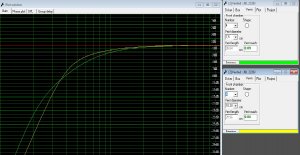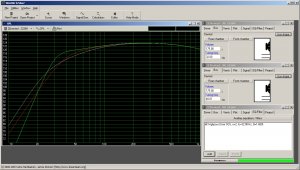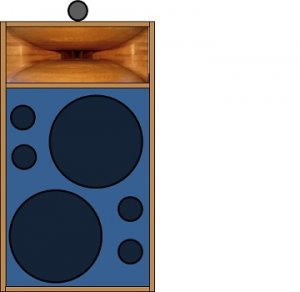Når det gjelder forsterker til disse høyttalerne så har jeg mange muligheter med 1 stk F2J (2x5 watt singel ended JFET klasse A) og 2 stk F4 (opptil 2x25 watt push pull Mosfet klasse a).
F4 kan brukes på følgende måter:
2x25 watt, NB! Unity gain, dvs enkelt sagt 1 volt inn = 1 volt ut, altså, preampen må være potent
1x25 watt parallellkoblet som gjør den stabil ned til 2 ohm / 100 watt
1x100 watt brokoblet fra balansert preamp (XLR inngangen på F4 er kun til dette formålet)
2x25 watt som powerbuffer etter en fleawatt SET rørforsterker (her må det settes på en motstand mellom + og - på høyttalerterminalen
Pass Labs preampen min har både balansert og singel endede utganger (den gir ca 14 volt ut) Jeg kan f eks bruke F2J til å drive mellomtone og diskant og F4 til bassene.
Bassene kan drives på følgende måter:
A) Parallellkoblede basser - brokoblede F4 (brokobling liker ikke lav impedanse)
B) Paralellkoblede basser - parallellkoblet F4 (stabilt 50 watt på 4 ohm)
C) Seriekoblede basser - brokoblede F4
D) En kanal til hver bass (altså 4x25 watt)
E) En rørforsterker foran F4 som driver hver sin bass (4x25 watt) slik at det blir pøst inn masse gain samt rørforsterkerens har harmoniske forvrengning som en signatur
Alternativ A-D gir en gain utfordring som gjør at volumet til mellomtone/diskant via F2J må strupes med ca 50% (erfaringsmessig)
Her er noen betraktninger om klangen til de forskjellige First Watt forsterkerne:
Somebody posted the question on www.diyaudio.com about the relative sound of the various amplifiers, and got the following answer from Jon Ver Halen at Lowther America:
Q: I am curious, since you are the only two who have listened to all the First Watt amps with Lowthers, as to which amp you personally like best?
A: Aha! Down to the meat of it all. There is no right answer, and it is part dependent on your taste, part on your music, and your source.
The F1 is super clean and dynamic. If your source is lean, your music will be lean. If your source is rich, your music will be rich. It is the real truth machine, with nothing taken out and nothing added. Ruthlessly revealing.
The F2 adds some 2nd harmonic to this. On lean source material this sounds better than the F1. It is putting a little color in your music, and on dry material it is a pleasant addition. Some like that additional color, some do not. Your choice.
The F3 sounds has a very light touch of sweetness. Sounds more like a great tube amp than any solid state amp I have heard, except that it has the same basic tonal characteristics from highs to lows - something most tube amps dream about.
The F4 sounds like a cross between the F1 and the F3. Cleaner than the F2, a touch of sweetness, but the truth is still front and center. I have not heard this amp in my system (yet), so my thoughts about this may change. It is a very exciting product.
Og her en kort beskrivelse av F4:
F4 Power Buffer
Like everything else from First Watt the F4 is a unique amplifier. It has no feedback and no voltage gain, only current gain. This design is sometimes called an impedance converting amplifier, but more commonly referred to as a buffer in this case, a power buffer.
The F4 is Class A impedance converting amplifier, having no voltage gain or feedback. Its input impedance is 47,000 ohms, and its output impedance is about 0.2 ohms. It is suitable for driving a high sensitivity loudspeaker with the output voltage of a preamp or other line-level audio source. It is also useful with a less sensitive loudspeaker in a bi-amped configuration where it takes input from the output of a conventional amplifier.
As a stereo amplifier with single-ended inputs and outputs, it will deliver up to 25 watts into 8 ohms with a damping factor of 40. It will do 50 watts into 4 ohms, and as a mono-block amplifier with parallel inputs and outputs, it will do about 100 watts into 2 ohms. As a mono-block amplifier with balanced inputs and outputs the power output rating is 100 watts into 8 ohms at 1%.
The amplifier operates Class A to 25 watts (50 peak), and the distortion is 2nd and 3rd harmonic in character, rising or declining in proportion to the output power. The amplifier has a direct coupled input and output, with a -0.5 dB rolloff around .1 Hz and 200 KHz. It does a clean square wave at 100 Khz.
Innspill på alternative konfigurasjoner mottas med takk







